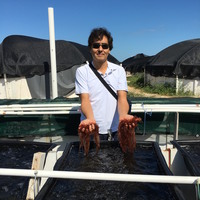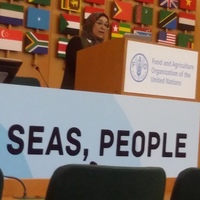
Tracy Yandle
Related Authors
Remo Caponi
University of Cologne
Daniel Robledo
Centro de Investigacion y Estudios Avanzados del IPN
Armando Marques-Guedes
UNL - New University of Lisbon
Poul Holm
Trinity College Dublin
Simon Springer
The University of Newcastle
Sahar F Mehanna
National Institute of Oceanography and Fisheries
Nicola Lupo
LUISS Guido Carli
forcep rio
Sultan Ageng Tirtayasa University
Gonzalo Rodriguez Rodriguez
University of Santiago de Compostela
Jose Fernandez Polanco
Universidad de Cantabria
InterestsView All (10)










Uploads
Papers by Tracy Yandle
Zealand’s commercial fishing to illustrate three different methods of measuring consolidation: the Herfindahl Hirschman Index (HHI), conditional Gini Coefficients, and conditional Lorenz curves. The Lorenz curve allows for conditional specification over stratified groupings, which yields straightforward interpretation and illustration of overall inequality for more nuanced interpretations.
grown considerably in recent years. At the same time, our understanding of the role of trust in human
interactions continues to grow. We use the case of New Zealand rock lobster (jasus edwardsii and
Jasus verrauxi) to ask the question “What is the role of trust in an individual’s decision to participate
in natural resource management institutions?” Using data from a survey of constituents of the
commercial rock lobster fishery, our analysis shows an inverted “U” relationship between trust and
participation. We suggest that this may be described as a “Goldilocks solution” in which having both
too much and too little trust is problematic; but a healthy level of is “just right.” Theoretical and policy
implications of these findings and directions for future research are explored.
regulation (such as tradable permits or transferable quotas)
are frequently offered as innovative solutions to many
environmental problems. Globally, one of the most wellestablished
forms of this approach is individual transferable
quotas (or ITQs) in fisheries management. Within the
natural resource management community, there is considerable
debate over the effects ITQs have on the fishing
industry and fisher behavior although this approach is not
well-established in the United States. The previously
imposed moratorium on ITQs in the United States has
expired and the 2006 reauthorization of the Magnuson-
Stevens Act explicitly provides for limited access privileges
(LAPs). A variety of fishers, regulators, and
conservation organizations are enthusiastically seeking to
introduce ITQ management. With debate over whether and
how ITQs should be used in American fisheries reinvigorated,
it is timely to examine the evidence on the social and
economic effects of ITQs in other nations’ fisheries. After
briefly summarizing the debate on ITQs, we examine the
case of New Zealand, one of the earliest and longest-lived
ITQ-based fisheries regimes. We use multiple data sources
and methods to analyze the extent to which industry consolidation
and aggregation has occurred, including surveys
of industry participants, expert interviews, reviews of
academic reports and analyses, analysis of trade publications,
and direct analysis of quota ownership patterns. This
analysis shows a more complex outcome than recent
debates in the ITQ literature would predict. These findings
suggest that policy makers considering ITQs can learn
from the experiences of other countries related to key
issues such as quota allocation, aggregation limits, transferability,
cost recovery, and resource sustainability when
designing ITQ and other LAP systems. It is also important
to explicitly identify economic and social objectives
and then carefully design ITQ regimes to meet these
objectives.
strengths and weaknesses of New Zealand’s fisheries co-management over its first six years. After presenting the current characteristics and activities of CSOs, the institutional analysis and development (IAD) Framework is used to examine the regime. Results show a pattern of strengths and weaknesses with some areas substantially improved since earlier waves of the survey, while other areas have experienced surprising setbacks. These results suggest that in 2005 the regime remained fragile. Finally, New Zealand’s recent move towards inshore ‘‘Shared Fisheries’’ management is explored in light of these findings.
management regimes. A key point of agreement is that secure long-term property rights provide an incentive for resource users to manage the resource sustainably. However, property rights mismatches create ambiguity and conflict in resource use. Though the term mismatches is usually associated with problems in matching temporal and spatial resource characteristics with institutional characteristics, I expand it here to include problems that can arise when property rights are incompletely defined or incompletely distributed. Property rights mismatches are particularly likely to occur over marine resources, for which multiple types of resource and resource user can be engaged and managed under a variety of regulatory regimes. I used New Zealand’s marine resources to examine the causes and consequences of these property rights mismatches. New Zealand is particularly interesting because its property-rights-based commercial fishing regime, in the form of individual transferable quotas, has attracted considerable positive attention. However,
my review of the marine natural resource management regime from a broader property rights perspective highlights a series of problems caused by property rights mismatches, including competition for resources among commercial, customary, and recreational fishers; spatial conflict among many marine resource
users; and conflicting incentives and objectives for the management of resources over time. The use of a property rights perspective also highlights some potential solutions such as the layering of institutional arrangements and the improvement of how property rights are defined to encourage long-term sustainability.
verreauxi) industry to illustrate what co-management is and how it develops. This is followed by an assessment of co-management in this regime. Development of co-management is an evolutionary process that requires commitment from both government and industry. Strengthened property rights and management expertise provide the incentives and tools to develop a robust co-management regime. However the characteristics of the property
rights bundle must be carefully matched to the regime’s biological, social, and regulatory setting.
management responsibilities to Commercial Stakeholder Organizations (CSOs). In 1999 and 2001, a mail survey was used to gather
data on the characteristics of CSOs, as well as the attitudes, and expectations of CSO leaders. Results are examined using Ostrom’s
design principles for long-lived institutions. The results suggest that CSOs are experiencing mixed success in developing institutions
that will be resilient to long-term challenges. Successes are identified and recommendations for the further development of this
management approach are offered.
Zealand’s commercial fishing to illustrate three different methods of measuring consolidation: the Herfindahl Hirschman Index (HHI), conditional Gini Coefficients, and conditional Lorenz curves. The Lorenz curve allows for conditional specification over stratified groupings, which yields straightforward interpretation and illustration of overall inequality for more nuanced interpretations.
grown considerably in recent years. At the same time, our understanding of the role of trust in human
interactions continues to grow. We use the case of New Zealand rock lobster (jasus edwardsii and
Jasus verrauxi) to ask the question “What is the role of trust in an individual’s decision to participate
in natural resource management institutions?” Using data from a survey of constituents of the
commercial rock lobster fishery, our analysis shows an inverted “U” relationship between trust and
participation. We suggest that this may be described as a “Goldilocks solution” in which having both
too much and too little trust is problematic; but a healthy level of is “just right.” Theoretical and policy
implications of these findings and directions for future research are explored.
regulation (such as tradable permits or transferable quotas)
are frequently offered as innovative solutions to many
environmental problems. Globally, one of the most wellestablished
forms of this approach is individual transferable
quotas (or ITQs) in fisheries management. Within the
natural resource management community, there is considerable
debate over the effects ITQs have on the fishing
industry and fisher behavior although this approach is not
well-established in the United States. The previously
imposed moratorium on ITQs in the United States has
expired and the 2006 reauthorization of the Magnuson-
Stevens Act explicitly provides for limited access privileges
(LAPs). A variety of fishers, regulators, and
conservation organizations are enthusiastically seeking to
introduce ITQ management. With debate over whether and
how ITQs should be used in American fisheries reinvigorated,
it is timely to examine the evidence on the social and
economic effects of ITQs in other nations’ fisheries. After
briefly summarizing the debate on ITQs, we examine the
case of New Zealand, one of the earliest and longest-lived
ITQ-based fisheries regimes. We use multiple data sources
and methods to analyze the extent to which industry consolidation
and aggregation has occurred, including surveys
of industry participants, expert interviews, reviews of
academic reports and analyses, analysis of trade publications,
and direct analysis of quota ownership patterns. This
analysis shows a more complex outcome than recent
debates in the ITQ literature would predict. These findings
suggest that policy makers considering ITQs can learn
from the experiences of other countries related to key
issues such as quota allocation, aggregation limits, transferability,
cost recovery, and resource sustainability when
designing ITQ and other LAP systems. It is also important
to explicitly identify economic and social objectives
and then carefully design ITQ regimes to meet these
objectives.
strengths and weaknesses of New Zealand’s fisheries co-management over its first six years. After presenting the current characteristics and activities of CSOs, the institutional analysis and development (IAD) Framework is used to examine the regime. Results show a pattern of strengths and weaknesses with some areas substantially improved since earlier waves of the survey, while other areas have experienced surprising setbacks. These results suggest that in 2005 the regime remained fragile. Finally, New Zealand’s recent move towards inshore ‘‘Shared Fisheries’’ management is explored in light of these findings.
management regimes. A key point of agreement is that secure long-term property rights provide an incentive for resource users to manage the resource sustainably. However, property rights mismatches create ambiguity and conflict in resource use. Though the term mismatches is usually associated with problems in matching temporal and spatial resource characteristics with institutional characteristics, I expand it here to include problems that can arise when property rights are incompletely defined or incompletely distributed. Property rights mismatches are particularly likely to occur over marine resources, for which multiple types of resource and resource user can be engaged and managed under a variety of regulatory regimes. I used New Zealand’s marine resources to examine the causes and consequences of these property rights mismatches. New Zealand is particularly interesting because its property-rights-based commercial fishing regime, in the form of individual transferable quotas, has attracted considerable positive attention. However,
my review of the marine natural resource management regime from a broader property rights perspective highlights a series of problems caused by property rights mismatches, including competition for resources among commercial, customary, and recreational fishers; spatial conflict among many marine resource
users; and conflicting incentives and objectives for the management of resources over time. The use of a property rights perspective also highlights some potential solutions such as the layering of institutional arrangements and the improvement of how property rights are defined to encourage long-term sustainability.
verreauxi) industry to illustrate what co-management is and how it develops. This is followed by an assessment of co-management in this regime. Development of co-management is an evolutionary process that requires commitment from both government and industry. Strengthened property rights and management expertise provide the incentives and tools to develop a robust co-management regime. However the characteristics of the property
rights bundle must be carefully matched to the regime’s biological, social, and regulatory setting.
management responsibilities to Commercial Stakeholder Organizations (CSOs). In 1999 and 2001, a mail survey was used to gather
data on the characteristics of CSOs, as well as the attitudes, and expectations of CSO leaders. Results are examined using Ostrom’s
design principles for long-lived institutions. The results suggest that CSOs are experiencing mixed success in developing institutions
that will be resilient to long-term challenges. Successes are identified and recommendations for the further development of this
management approach are offered.